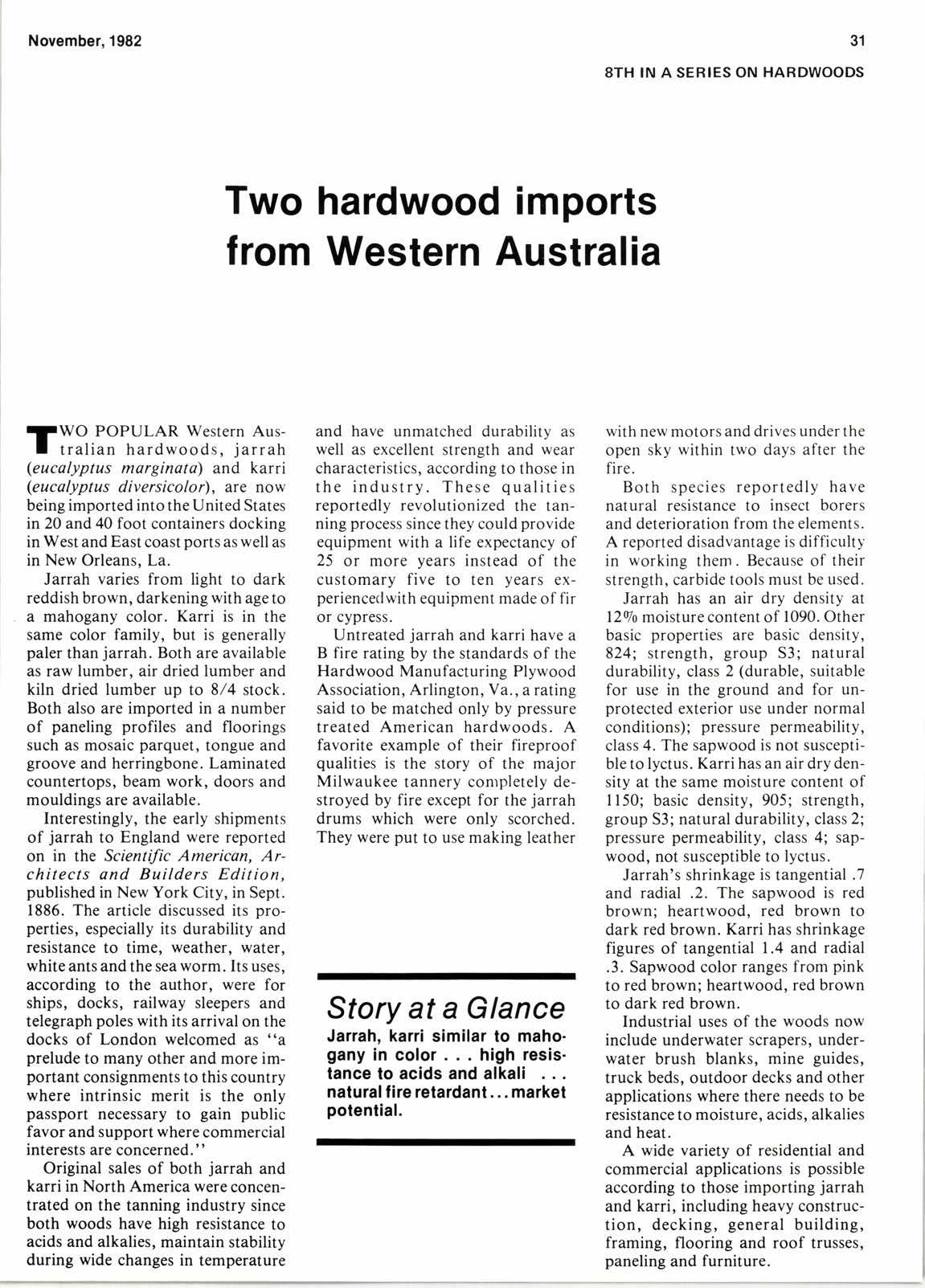
2 minute read
Two hardwood imports from Western Australia
TwO POPULAR Western AusI tralian hardwoods, jarrah (eucalyptus morginata) and karri (eucolyptus diversicolor), are now being imported into the United States in 20 and 40 foot containers docking in West and East coast ports as well as in New Orleans, La.
Jarrah varies from light to dark reddish brown, darkening with age to a mahogany color. Karri is in the same color family, but is generally paler than jarrah. Both are available as raw lumber, air dried lumber and kiln dried lumber up to 8/4 stock. Both also are imported in a number of panelirtg profiles and floorings such as mosaic parquet, tongue and groove and herringbone. Laminated countertops, beam work, doors and mouldings are available.
Interestingly, the early shipments of jarrah to England were reported on in the Scientific American, Architects and Builders Edition, published in New York City, in Sept. 1886. The article discussed its properties, especially its durability and resistance to time, weather, water, white ants and the sea worm. Its uses, according to the author, were for ships, docks, railway sleepers and telegraph poles with its arrival on the docks of London welcomed as "a prelude to many other and more important consignments to this country where intrinsic merit is the only passport necessary to gain public favor and support where commercial interests are concerned."
Original sales of both jarrah and karri in North America were concentrated on the tanning industry since both woods have high resistance to acids and alkalies, maintain stability during wide changes in temperature and have unmatched durability as well as excellent strength and wear characteristics, according to those in the industry. These qualities reportedly revolutionized the tanning process since they could provide equipment with a life expectancy of 25 or more years instead of the customary five to ten years experiencedwith equipment made of fir or cypress.
Untreated jarrah and karri have a B fire rating by the standards of the Hardwood Manufacturing Plywood Association, Arlington, Va., a rating said to be matched only by pressure treated American hardwoods. A favorite example of their fireproof qualities is the story of the major Milwaukee tannery conrpletely destroyed by fire except for the jarrah drums which were only scorched. They were put to use making leather
Story at a Glance
Jarrah, karri similar to mahogany in color . high resis. lance to acids and alkali natural f ire retardant... market potential.
with new motors and drives under the open sky within two days after the fire.
Both species reportedly have natural resistance to insect borers and deterioration from the elements. A reported disadvantage is difficulty in working them . Because of their strength, carbide tools must be used.
Jarrah has an air dry density at l29o moisture content of 1090. Other basic properties are basic density, 824; strength, group 53; natural durability, class 2 (durable, suitable for use in the ground and for unprotected exterior use under normal conditions); pressure permeability, class 4. The sapwood is not susceptible to lyctus. Karri has an air dry density at the same moisture content of ll50; basic density, 905; strength, group 53; natural durability, class 2; pressure permeability, class 4; sapwood, not susceptible to lyctus.
Jarrah's shrinkage is tangential .7 and radial .2. The sapwood is red brown; heartwood, red brown to dark red brown. Karri has shrinkage figures of tangential 1.4 and radial .3. Sapwood color ranges from pink to red brown; heartwood, red brown to dark red brown.
Industrial uses of the woods now include underwater scrapers, underwater brush blanks, mine guides, truck beds, outdoor decks and other applications where there needs to be resistance to moisture, acids, alkalies and heat.
A wide variety of residential and commercial applications is possible according to those importing jarrah and karri, including heavy construction, decking, general building, framing, flooring and roof trusses, paneling and furniture.










